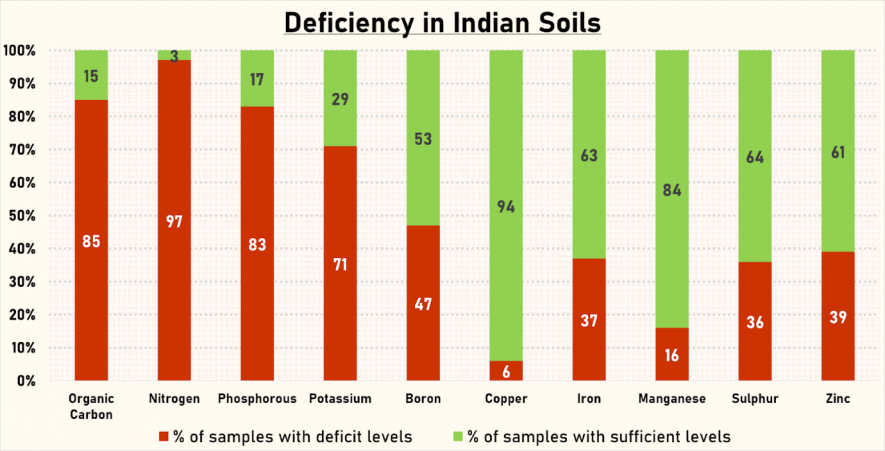Indian Soils Extremely Deficient in Nutrients

Representational image. | Image Courtesy: Pixabay
The levels of organic carbon and macronutrients in Indian soils are either “very low”, “low” or “medium”.
According to a recent Centre for Science and Environment (CSE) report, about 85% of soil samples are deficient in organic carbon. Of these samples, about 15% contain very low levels of organic carbon, 49% contain low levels of organic carbon and 21% contain medium levels of organic carbon.
Similarly, 97% of the samples are deficient in nitrogen—out of these, 45% of the samples show very low levels of nitrogen, 36% low levels of nitrogen and 16% medium levels of nitrogen.
The report found that 83% of the samples are deficient in phosphorus—17% reveal very low levels of phosphorus, 31% reveal low levels and 35% medium levels. About 71% of the samples are deficient in potassium. Of these samples, about 5% have very low levels of potassium, 14% low levels and 52% medium levels.
Indian soils are also deficient in micronutrients with more samples showing deficit in boron, iron, sulphur and zinc and a lesser number in copper and manganese.
As per the Soil Health Card scheme, initiated by the Union ministry of agriculture and farmers welfare in 2014-15, the soil is considered deficient in macronutrients, like nitrogen, organic carbon, phosphorus and potassium if the levels of these macronutrients in the soil are “very low”, “low” or “medium” and sufficient if the levels of the macronutrients are “high” or “very high”.
Similarly, soils containing less than the prescribed level of a micronutrient—boron, copper, iron, manganese, sulphur and zinc, etc.—are considered deficient and soils containing equal to or more than the prescribed levels of micronutrients are considered sufficient.

According to the report, organic carbon deficiency is widespread across the country—24 states and Union Territories (UTs) have, at least, half of their soil samples deficient in organic carbon. Out of these, seven states have more than 90% deficient samples. Haryana’s soils are the most deficient in organic carbon, followed by those of Punjab, Uttar Pradesh, Rajasthan, Tamil Nadu, Mizoram, and Andaman and Nicobar Islands.
Nitrogen deficiency is also widespread and severe—32 states and UTs have nitrogen deficiency in at, least, half of their soil samples. Of these, 27 states and UTs have more than 90% deficient samples. Fifteen states and UTs have nitrogen deficiency in almost all of their samples—Andaman and Nicobar Islands, Dadar and Nagar Haveli, Daman and Diu, Bihar, Delhi, Haryana, Kerala, Madhya Pradesh, Manipur, Mizoram, Odisha, Puducherry, Rajasthan, Tamil Nadu, Uttarakhand and Uttar Pradesh.
The report highlighted that replenishment of nutrients is crucial if crop production is to continue in the long run. “Recycling of organic matter or biomass can be done through the application of organic fertilisers and practices like growing green manure crops or mulching,” the report stated. “Some other practices that help regain nutrients include crop rotation, inter-cropping and mixed cropping. Biofertilisers can enable nutrient mobilisation and solubilisation in soil. Chemical-based fertilisers directly provide nutrients to the soil.”
Get the latest reports & analysis with people's perspective on Protests, movements & deep analytical videos, discussions of the current affairs in your Telegram app. Subscribe to NewsClick's Telegram channel & get Real-Time updates on stories, as they get published on our website.
























